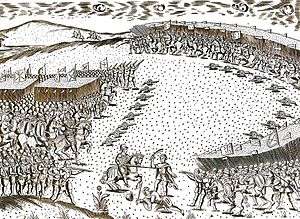Abu Marwan Abd al-Malik I Saadi
| Abd al-Malik أبو مروان عبد الملك الغازي | |||||
|---|---|---|---|---|---|
| Sultan of Morocco | |||||
 Abd al-Malik crushed the Portuguese at the Battle of Alcácer Quibir in 1578. | |||||
| Reign | 1576–1578 | ||||
| Successor | Ahmad al-Mansur | ||||
| Died | 4 August 1578 | ||||
| |||||
| Dynasty | Saadi Dynasty | ||||
| Father | Mohammed ash-Sheikh | ||||
| Religion | Islam | ||||
Abu Marwan Abd al-Malik I (Arabic: أبو مروان عبد الملك الغازي), often simply Abd al-Malik or Mulay Abdelmalek (died 4 August 1578), was the Saadi Sultan of Morocco from 1576 until his death right after the Battle of Ksar El Kebir against Portugal in 1578.
Saadi Prince
Abd al-Malik was one of the sons of the Saadi Sultan Mohammed ash-Sheikh, who was assassinated by the Ottomans in 1557 by order of Hasan Pasha, son of Barbarossa, as he was preparing for an alliance with Spain against the Ottomans.
One of his brothers Abdallah al-Ghalib (1557–1574) then took power and ascended to the throne. He planned to eliminate his other brothers in the process. Abd al-Malik had to escape from Morocco and stay abroad until 1576, together with his elder brother Abdelmoumen and his younger brother Ahmed.[1]
Exile to the Ottoman Empire (1557–75)
Abd al-Malik spent 17 years among the Ottomans with his brothers, most of the time in Algeria, benefiting from Ottoman training and contacts with Ottoman culture.[1] Abdelmoumen was named governor of the city of Tlemcen by the ruler of the Regency of Algiers, Hasan Pasha, but Abdelmoumen was assassinated there in 1571.

Abd al-Malik visited Istanbul on several occasions. He went to the Ottoman capital in July 1571, and then was involved with his brother al-Mansur in the Battle of Lepanto on the Ottoman side on 7 October 1571.[2][3] He was captured during the battle and transported to Spain and then brought before the Spanish king Philip II. The Spanish king decided, upon the advice of Andrea Gasparo Corso, to hold him captive in the Spanish possession of Oran, in order to use him when the opportunity arose. Abd al-Malik however managed to escape from Oran in 1573 and travelled back into the Ottoman Empire.
In January 1574, while in Constantinople, his life was saved during an epidemic by French physician Guillaume Bérard. As a result, they later became friends. When Abd al-Malik became Sultan, he asked Henry III of France that Guillaume Bérard be appointed Consul of France in Morocco.[4]
In 1574, Abd al-Malik participated in the conquest of Tunis by the Ottomans.[1] Following this success, he again visited Constantinople, and obtained from the new Ottoman ruler Murad III an agreement to help him militarily to regain the Moroccan throne.
Reign (1576–78)
Reconquest of Morocco with the Ottomans

Abd al-Malik joined the Ottomans and was able to invade Morocco with the help of an Ottoman force of 10,000 soldiers dispatched from Algiers in 1576. The Ottoman force captured Fez during that year.
Abd al-Malek recognized the Ottoman sultan Murad III as his Caliph, and reorganized his army on Ottoman lines and adopted Ottoman customs, but negotiated for the Ottoman troops to leave his country, in exchange for a large payment in gold.[5]
In the following period he tried to revive trade with Europe and especially England, starting an Anglo-Moroccan alliance with Elizabeth I. According to Richard Hakluyt, as quoted by Edmund Hogan, ruler "Abdelmelech" bears "a greater affection to our Nation than to others because of our religion, which forbids the worship of Idols".[6] He wrote a letter in Spanish to Elizabeth in 1577.[2]
Battle of Ksar El Kebir (1578)
After losing the throne to Abu Marwan Abd al-Malik I in 1576, the ousted Sultan Abu Abdallah Mohammed II had been able to flee to Portugal and then convince King Sebastian to launch a military campaign against Morocco. The campaign turned out to be a complete failure after they were defeated at the Battle of Ksar El Kebir in 1578. The battle ended after nearly four hours of heavy fighting and resulted in the total defeat of the Portuguese and Abu Abdallah's army with 8,000 dead, including the slaughter of almost the whole of the country’s nobility, and 15,000 taken prisoner; perhaps 100 survivors escaped to the coast. The body of King Sebastian, who led a charge into the midst of the enemy and was then cut off, was never found.
The Sultan Abd Al-Malik also died during the battle, but from natural causes (as he was already very ill and the effort of riding was too much for him), and the news was concealed from his troops until total victory had been secured. Abu Abdallah attempted to flee but was drowned in the river. For this reason, the battle was known in Morocco as the Battle of the Three Kings.
Upon his death, he was succeeded by his brother Ahmad al-Mansur (1578–1603).
See also
- Anglo-Moroccan alliance
- Islam and Protestantism
- List of rulers of Morocco
- History of Morocco
- Saadi Dynasty
Notes
- 1 2 3 The last great Muslim empires: history of the Muslim world by Frank Ronald Charles Bagley, Hans Joachim Kissling p.103ff
- 1 2 Europe through Arab eyes, 1578-1727 by Nabil I. Matar p.75
- ↑ "Abd al-Malik fought on the Ottoman side in 1571 in the great sea battle of Lepanto." in Ahmad al-Mansur: the beginnings of modern Morocco Mercedes García-Arenal OneWorld, 2009 p.10
- ↑ Cervantes in Algiers: a captive's tale by María Antonia Garcés, p.277 note 39
- ↑ The Cambridge History of Africa by J. D. Fage p.408-
- ↑ Shakespeare: The critical complex by Stephen Orgel p. 293
Bibliography
- Stephan and Nandy Ronart: Lexikon der Arabischen Welt. Artemis Verlag, 1972 ISBN 3-7608-0138-2
| Preceded by Abu Abdallah Mohammed II |
Saadi Dynasty 1576–1578 |
Succeeded by Ahmad al-Mansur |